Movie Review By: SSJKamui (Reviewer Forum link)
Year: 2008
Directed by: Yoshiro Nishimura
Written by: Kengo Kaji, Sayako Nakoshi and Yoshihiro Nishimura
IMDB Reference
Degree of Cyberpunk Visuals: High
Correlation to Cyberpunk Themes: Medium
Key Cast Members:
Ruka: Eihi Shiina
Keyman: Itsuji Itao
Tokyo Police Chief: Yukihide Benny
Barabara-Man: Jiji Bû
Bar Independent Diner: Ikuko Sawada
Dog Girl : Cay Izumi
Rating: 5 out of 10
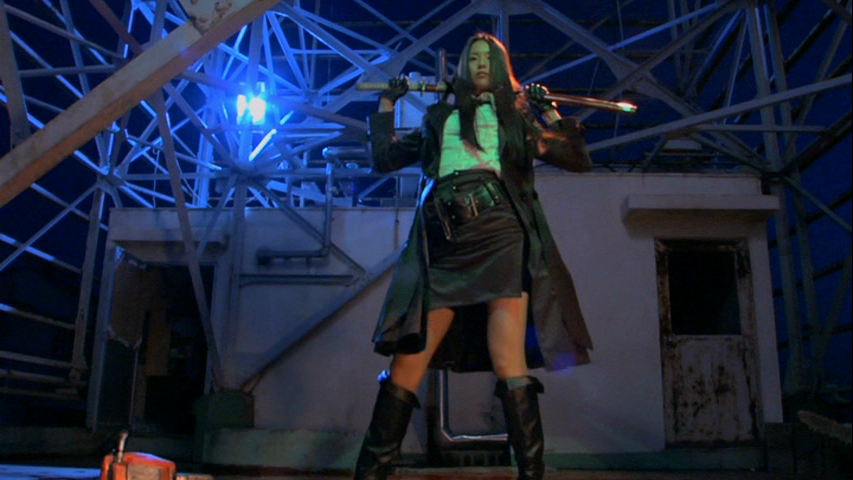
Looking for a good scare this Halloween? Tokyo Gore Police may have what you’re looking for. Be warned: The visuals may be more… “intense” than what most would go for. Let’s say this shit makes your “Friday the 13th, Nightmare on Elm Street, Texas Chainsaw Massacre,” and “Saw” franchises look like Disney productions.
Overview: Tokyo Gore Police is a “Japanese Cyberpunk” splatter movie created by the producers of “The Machine Girl”. The movie is a remake of the independent movie “Anatomia Extinction”. Currently, a prequel short for the movie is in production.
Plot: In the future, the privatized police, under control of the “Tokyo Police Corporation” has developed an extremely brutal, merciless law and order type way of action.
The whole society developed into a sadistic, pervert society with an obsession of violence.
Ruka is the daughter of a policeman who was assassinated in a very brutal way before the police was privatized. Because Ruka saw the assassination of her father, she was traumatized and developed self harming behavior. After the death of her father, she was adopted and raised by the chief officer of the Police Corporation.
Later, an outbreak of a virus causes the infected people to mutate into bizarre monsters. The virus was created by a mad scientist to take revenge on the death of his father by the police. Later, it’s revealed that the father of the mad scientist is actually the murderer of Ruka’s father and the reason for the assassination was actually a conspiracy within the police, where the chief officer of the new Police Corporation has got a key role.
After most mutants were killed by Ruka, the police start a Purge like action where also seemingly randomly civilians get hunted. Among the murdered civilians is also a close friend of Ruka. Because of this and the involvement of her foster father in the assassination of her biological father, Ruka gets mad and starts mutating, too. She fights the policemen and then encounters her foster father. Her father, who started mutating, too and using injections of the virus to get more powerfull starts fighting against his foster daughter.
The story of the film is full of sick moments and extremely brutal scenes. For example, a mutant is a prostitute who eats her customers. There is also a huge amount of psycho-sexual horror, like in the works of H.R.Giger and most other “Japanese Cyberpunk movies”, but some scenes are more funny than scary.

“Vagina dentata” much?
The movie has got a huge amount of black humorous moments. For example, like in the Robocop movies, in the movie, there are certain fake commercial scenes advertising very sick things or speaking funny warnings. For example, knifes for self cutting are advertised in an extremely sick way and there is a television warning that committing Hara-kiri will result in your death. The chief officer of the police also has got a kind of “Cyborg Dog” who looks like a BDSM Costume.
The depiction of the police in the movie is also the clichéd “ultra violent law and order” policemen type which often appear in Cyberpunk works. The most famous ones are Robocop and Judge Dredd.
I agree with the Review on DVD Times.com , the film definitely reminds on Blade Runner, but it mostly lacks the brilliant atmosphere of Blade Runner. Only the driving scene through the streets of Tokyo and the Bar Scene catch a similar, brilliant atmosphere.
The opening scene, where at first, all is peacefull, but suddenly, Rukas father is killed in a very brutal way was one of the best depictions of the concept of “the Real” by the psychologist Jacques Lacan, a kind of traumatic, unexplainable event suddenly appearing which is threatening the function of the mind, I have ever seen.
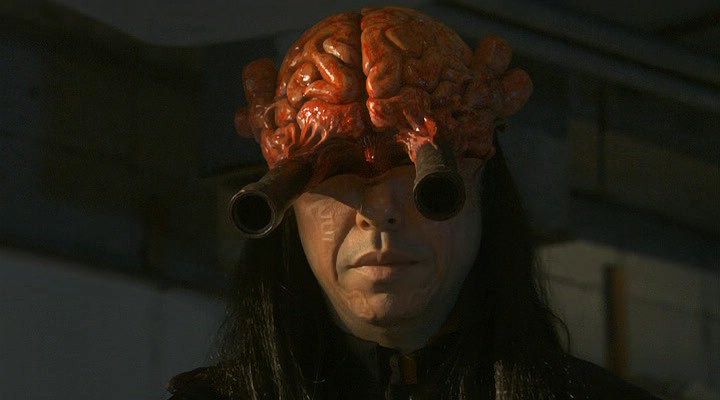
Speaking of unexplainable events suddenly appearing which is threatening the function of the mind…
On most parts, the movie is extremely entertaining, but I don’t understand these “police purge” scenes near the end of the movie and to me, these scenes doesn’t really make sense. The story of the movie isn’t very intellectual, but it’s a good satire on the actions of these populist law and order politicians. The story is also more complex than these Japanese Cyberpunk movies starring Dr.Joseph Mengele like Mad Scientists performing cruel experiments.
Conclusion: Tokyo Gore Police is a truly sick brutal movie like most Japanese cyberpunk films. The story is also not very original and is mostly extremely thin. Nevertheless, it’s still an entertaining satire which can’t be taken seriously. Like all “Japanese Cyberpunk movies”, if you have got problems with violence, you won’t like this movie. Most of the horror scenes aren’t as scary as the horror scenes of the movies Yu On and The Ring, although these movies are less brutal.
Movie Review By: Mr. Roboto
Year: 2009
Directed by: Ondi Timoner
Written by: Ondi Timoner
IMDB Reference
Degree of Cyberpunk Visuals: Low
Correlation to Cyberpunk Themes: Low
Overview. Josh Harris, ever hear of him? Me neither… not until I heard of this movie. The “Wharhol of the Web” came up with the ideas of Internet TV (Pseudo.com), statistic gathering, and the basis for many of today’s social networking sites. So why isn’t he mentioned as often as Gates or Jobs? Timing; The Internet wasn’t able to handle the bandwidth needed for his visions. Not until broadband became commonplace for net access. But by then, it was too little, too latte for Harris who left the high-tech scene and expatriated to Africa to avoid creditors.

Indie filmmaker Ondi Timoner spent 10 years with Harris documenting his rise as an Internet entrepreneur, to the Quiet experiment, and his eventual downfall.
Rise of a dot-com kid. Harris arrives in New York City with only a few hundred dollars in his pocket, an a couple of ideas for the Internet in his head. His first venture is JupiterResearch, an Internet research company. In 1993, he envisioned television on the Internet and founded Pseudo.com. Pseudo not only had television (more like early vlogging before anyone heard of vlogging), but associated chat rooms for the shows. When he sold Pseudo, Harris’ net worth was now $80 Billion US. Luckily for him, he got out before the big bubble burst, but he decided to use that money for a “little” experiment…
The experiment: In December 1999, under some buildings in Manhattan, Harris constructed a “bunker” where he would gather 100 people. The people would be living in a commune-type setting with “pod” beds while under constant surveillance, and be subject to “interrogations,” though they would have free meals and a shooting range. The experiment’s aim was simple; To see how these people would behave living in an Orwellian setting. Things start smoothly enough, then went downhill fast. Eventually, after the new millennium, the NY Police and Fire departments shut the experiment down believing the experiment was actually a doomsday cult.
Though that experiment was over, he wanted to test his theory further by moving in with his girlfriend and installing net-cameras in their apartment. An incident that nearly leads to rape causes her to leave, and soon Harris has a mental breakdown. While Harris is considered an artist by some, there are some signs that he may have been insane in the mainframe before the breakdown.

Afraid of clowns? You will be!
The Point of the experiments? It should be obvious now that the technology has caught up to Harris’ ideas what the point is: How much of our privacy will we sacrifice for connecting to others, or for fame itself?

“Everything is free… except the video that we capture of you. THAT we own.”
If you’ve ever encountered targeted ads, you already have seen the tip of the iceberg. Worse yet, the information they gain from what you willingly surrender they can now sell to others. Harris’ “Quiet” experiment was a not-so-quiet warning about where we were headed… rather, where we are now.
Conclusion. Call Josh Harris what you want… visionary, entrepreneur, voyeur, prophet, ca-ca-cuckoo-for-cocoa-puffs… the message he sent with his experiments is only now being realized by a small handful of people. For the rest, they may not realize or even care about how much “exposure” they’re really getting for their 15 minutes. Looking for a treatise on the negative effect of technology? We Live In Public answers that question in no uncertain terms.
Movie Review By: Mr. Roboto
Year: 2010
Directed by: Miguel Sapochnik
Written by: Garrett Lerner & Eric Garcia (based on his novel The Repossession Mambo)
IMDB Reference
Degree of Cyberpunk Visuals: High
Correlation to Cyberpunk Themes: High
Key Cast Members:
Remy: Jude Law
Jake: Forrest Whitaker
Beth: Alice Braga
Frank: Leiv Schreiber
Rating: 5 out of 10
New Eye: $345K
New Heart: $975K
New Liver: $756K
New Kidney: $524K
Not Making Payments for 90 Days: YOUR ASS!
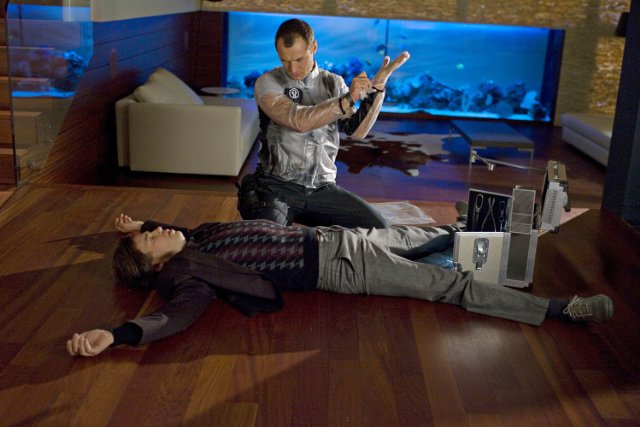
“Relax, it’s totally painless! I won’t feel a thing! Besides, once you’re dead you won’t even notice.”
Overview: The timing of this movie’s release is eerie. Originally scheduled for April 2, it was instead released March 19, the same weekend that the US Congress scheduled a vote on Health Care Reform. Coincidence? Maybe, but this film could be considered a vision to what could happen if HCR fails (or succeeds, depending on how you want to look at it). No, cities won’t turn into a Blade Runner landscapes, but a corporation does finds a way to make its “customers” live on borrowed time… literally and figuratively… while they profit.
The Story: Megacorporation “The Union” has apparently cornered the market on artificial organs, or “artiforgs.” This, plus a (continuing) global economic meltdown, has made such implants a very expensive purchase, even to save a life. To make them affordable to those who can’t buy outright, The Union has financing plans available similar to today’s car and/or home loans. But there is a downside to such financing; Fail to make a payment for 90 days, and The Union will send repossession men to retrieve the organ. The organs have an RFID-style tracking system installed, so repo men can track down the delinquent, cut them open, and retrieve the organ. Remy (Jude Law) and Jake (Forest Whitaker), former schoolmates and soldiers, are The Union’s best repo men.
Remy has a wife and a son, and lately, she has been pressuring Remy to switch from repossession to sales which doesn’t pay as much but would allow him to spend more time with his family. During one repossession mission, a defibrillator malfunctions and nearly kills Remy. He awakens in a hospital with a Union financed Jarvik artiforg heart… and the bill for it.

The Corporate Brand: Not just for salarymen.
Tin Man. A new heart wouldn’t necessarily be the end of the world, but when Remy tries a repossession he couldn’t go thorough with it. Physically, his normally steady hands start shaking, and mentally his tell-tale heart can be heard. It’s as though losing his heart actually gives him a heart; Losing part of his humanity made him more human. His new Jarvik heart must have had an empathy attachment, since he is now unable to do repossessions… or even sales as his graphic descriptions of repossessions scares customers.
Unable to make money, Remy soon finds himself being hunted by repo men, including his friend Jake.
The cat in the… box? At a couple of moments in the movie, Remy refers to an experiment where a scientist places a cat inside a box with a machine that emits poison gas at some point. We are simultaneously alive and dead, was the scientist’s conclusion, but Remy didn’t understand what that meant until he was being hunted himself, and found himself identifying with the cat:
We can either lick our paws and wait for the inevitable, or we can fight and claw our way out of the box.
Remy chooses to fight his way out, and hopes to liberate other repo targets from the system.
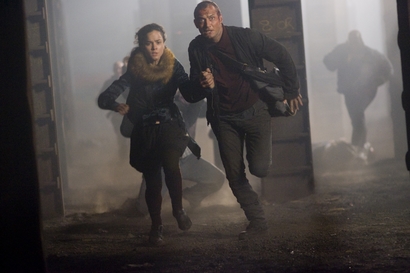
“Welcome to your world, repo man.”
OK, should be go see it? There’s not much new to see. In fact, some of the city scenes could be confused for Blade Runner, only without the spinners flying about. There is the contrast of the sterile environs of The Union’s offices (especially the “clean room” that doesn’t stay clean) and the run-down part of town known as the “black hole.” There’s also Beth, the woman who is almost nothing but artiforgs, including enhanced eyes and ears. And of course, The Union and its payment-and-repossession program that can be called predatory. Pretty much standard issue cyberpunk stuff.
UPDATE: After having seen Repo! The Genetic Opera, I can say there is not much similar between these two movies. With Repo Men’s cyberpunk tomes vs. Repo!’s goth atmosphere, we can keep this at 5 stars.
Conclusion: Can’t really say Repo Men is a great movie, or even a good one. It does it’s job well enough, but lacking originality, the current politics with health care reform… and some obligatory operational blood… may be enough to turn many off. Adequate enough to waste a couple of hours on, but only IF you’re not into operas.
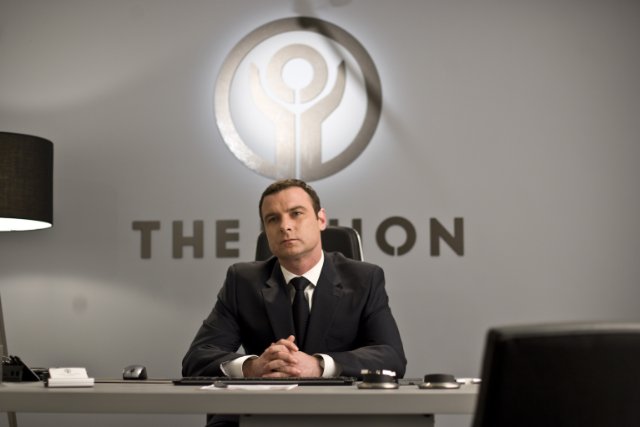
“You owe it to your family. You owe it to yourself.”
Movie Review By: Mr. Roboto
Year: 1998
Directed by: Mick Garris
Written by: Preston Sturges, Jr. and Mick Garris (teleplay), Peter James (based on his novel “Host”)
IMDB Reference
Degree of Cyberpunk Visuals: Moderate
Correlation to Cyberpunk Themes: Moderate
Key Cast Members:
Dr. Joe Messenger: Peter Gallagher
Karen Messenger: Mimi Rogers
Juliet Spring: Bridgette Wilson
Albert: Tom Nibley
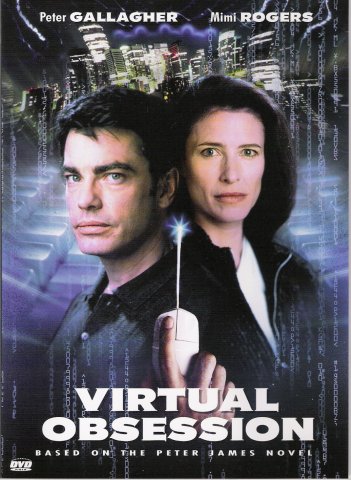
Overview: Originally, it was a made-for-TV movie that aired on ABC (who said “It makes Fatal Attraction seem like a walk in the park.”), now it makes its rounds on cable under the name Host.
I came across this little ditty a few weeks ago at a local flea market. By the way the cover looked, and the story description on the back of the case, I had the impression that this was a cyberpunk movie. After doing some research and discovering it was made by Hallmark Entertainment, VO suddenly went from possible cyberpunk movie to “chick-flick” … not what I was looking for. Still, the plot description kept nagging me to watch it. So I did…
It’s definitely a direct-to-TV-quality melodrama, but there are some undertones of cyberpunk, especially with technology redefining humanity.
Synopsis: Dr. Joe Messenger has created the ultimate super-computer to run Salt Lake City’s power grid, but “Albert” (as in “Einstein,” who appears as a holograph at times) has a greater purpose: Cameras, microphones, and other sensory-input devices from around the city… and the world… feed Albert data constantly, helping it learn about humanity. Joe is looking to create the first post-biological consciousness.
Joe hires Juliet Spring to assist him, but her life is threatened by an inoperable aneurysm. She is desperate to use Albert for a project of her own: Juliet wants to upload a human brain (hers specifically) to achieve immortality, or at least until they discover a way to operate on it while she is in cryogenic sleep. Juliet begins an affair with Joe, putting a strain on his marriage, and slowly becomes obsessed with him. Just before she dies, she uploads herself to Albert and her body is frozen. While in deep-freeze, people start making demands for her body and eventually it is destroyed (the sad finale is when Karen discovers Juliet’s head in the basement freezer and, after confronting Joe, tosses it into the street where it shatters into chunky pieces). Juliet begins using Albert’s connections to take revenge, and demands that Joe joins her in her “Eden,” going so far as threatening his family.
Fatal Attraction, fer sure! The only thing missing is the obligatory “I’m not gonna be ignored, Dan!” line. From the first time we see her during the interview at the Artificial Intelligence Center, we can tell Juliet is targeting Dr. Messenger for something. Even after her death and destruction, she is still desperate to have Joe with her.
If it wasn’t for the Lawnmower Man-like idea of uploading a consciousness into cyberspace, this would just be another psychotart-gets-wet-panties-for-cuckold film.
Now for the good parts! Fortunately, the more memorable scenes and lines in the movie deal more with the impact of technology on the meaning of humanity than on one girl’s obsession for a married man:

“We’re trying to create a new consciousness… We’re trying to crate a mind. Something aware of itself… A being that can think and choose for itself, on its own terms.”
“We’re not living in a science fiction movie, Carl. Post-biological man is to be pure intelligence. There wouldn’t be any selfish interest….” To test Juliet’s theory, they try to upload a rat’s brain into Albert. They succeed, though the rat dies with a high-pitched shriek:
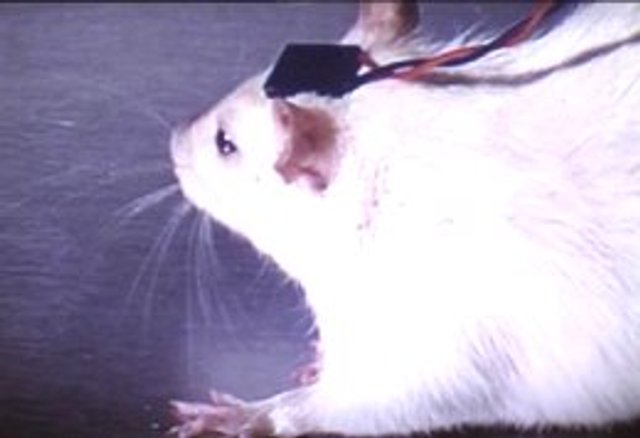
“Here’s my hypothesis. The rat brain is downloaded and at time point zero, it becomes conscious. It responds to its newborn consciousness with that sound. And somewhere between zero and 21-point-734 seconds it senses competition with the living rat, the organic rat, and kills it.”
“What if silicon consciousness is unbearable to creatures that were once alive, once organic? What if stripping the consciousness from the body is agony?” After uploading herself to Albert and “seeing” her meat body be destroyed, Juliet undergoes some major personality changes, becoming almost god-like (or goddess-like):
“Maybe you can’t separate the body from the mind. Maybe there’s something that binds us to the flesh. Loose the body and you loose the humanity. Destroy the container and you destroy the soul.”
“Imagine what an active intelligence with spontaneous access to all of mankind’s recorded knowledge is capable of.” 
What do you call a computerized brain that turns a city’s light grid into a message board? Insane in the mainframe.
Conclusion: While not the most “hard core” in terms of cyberpunk themes and visuals, there is enough cyber-transhuman philosophizing to make this made-for-TV chick-flick interesting for guys to check out… IF you have stomach for such fare.
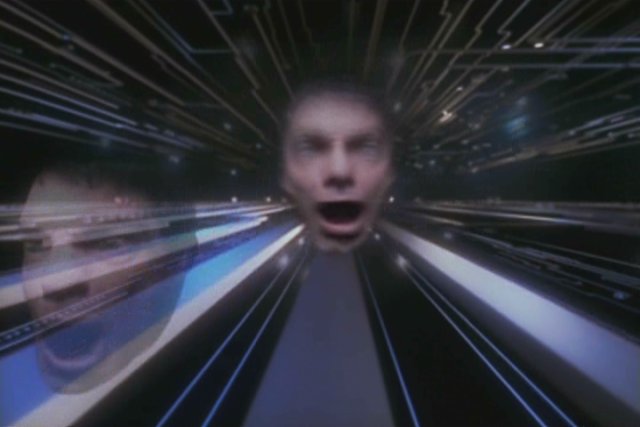
Movie Review By: SFAM
Year: 2005
Directed by: Jason Tomaric
Written by: Jason Tomaric
IMDB Reference
Degree of Cyberpunk Visuals: Medium
Correlation to Cyberpunk Themes: High
Key Cast Members:
- Derek Strombourg: Jeff St. Clair
- Orin Stalward: Bill Caco
- Joshua Adams: Gary Skiba
- Valerie Renee Law: Mira DelForna
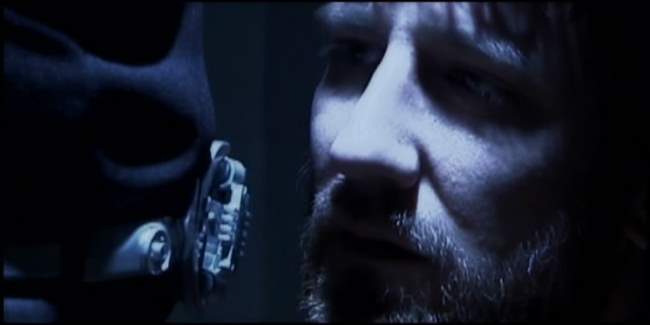
Overview: There have been some truly interesting projects in the no-budget Sci-Fi indie movie business. One of the most impressive is Jason Tomaric’s Cl.One. Made for a budget of only 25,000, Tomaric tapped into the power of mass collaboration to solicit help from half the city of Cleveland, Ohio. While I might have a number of issues with the movie itself, nobody viewing the effects and look of Cl.One would ever think they were produced on a shoestring. In short, the Tomaric was able to pull together a far more professional looking movie based on personality alone. In a Wired article, Tomaric guestimates that he received somewhere between 1.7 to 2 million in free goods and services. The tagline for this movie is “3,000 extras. 48 locations. 650 digital effects…. Made by one kid out of his parents’ basement.” Count me as impressed!

The Story: Due to a horrible nuclear world war, the last vestiges of humanity can no longer procreate. The damage caused by radiation has genetically mutated the remaining inhabitants. So now, humanity exists in pockets of globed cities that are administered in a surveillance-type society mode. The cities are connected via a series of high—speed tunnel trains. The hope is that genetic research and cloning will offer a continuation of the species. Unfortunately, an anti-government resistance movement called Spectrum has also arisen.
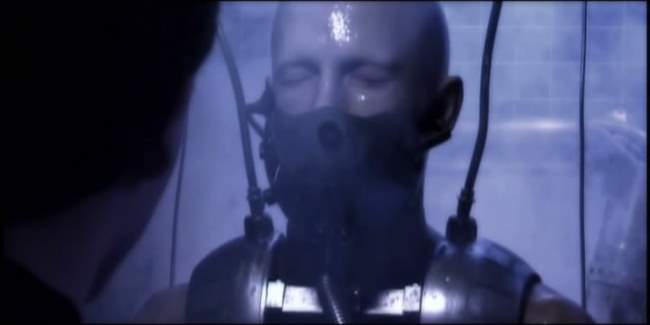
Unfortunately, cloning seems to yield fully formed, but soul-less, mindless humans. In essence they are empty shells. To transform these clones into living beings, it is hypothesized that a human will be found who’s DNA has not been irradiated, and who’s genetic sequence will be an exact match needed to give life the clones. In doing so, humanity’s future will be restored.
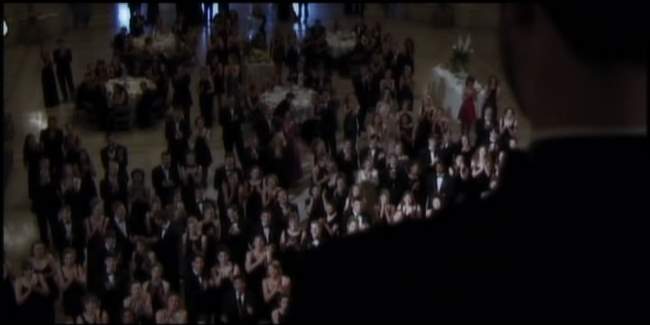
Chancellor Derek Strombourg, the head New Athens who is beset by the loss of his only child who died due to radiation damage, has created a school of the best and brightest. But this is just a front for his real goal – to test all students with the hopes of finding the “one” – the one with the genetic match necessary to bring the dormant clones to life. After four years of searching, he finally has a match - Student Orin Stalward. To make this work, he has to initiate the experiment right at the moment that Stalward is planning on taking his own life. To make matters worse, Spectrum, the anti-government “terrorist” organization headed up by Joshua Adams is causing significant problems to Strombourg’s leadership, both in its attacks and in its intrusion into Orin’s life.
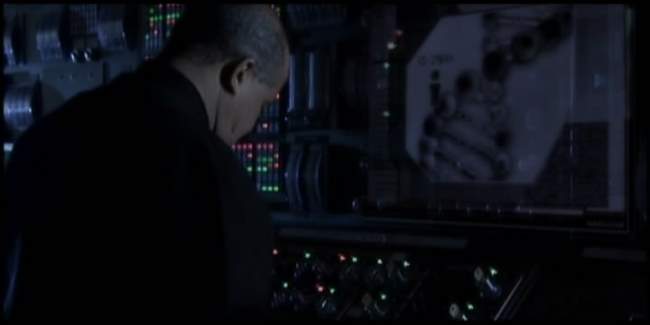
The Pacing and Story Issues: From a pacing standpoint, Cl.One starts off with an impressive “bang” and goes downhill from there. Cl.One is at best a very complicated story. I consider myself fairly astute at this point in picking up various cyberpunk themes and storylines, but still found that it took me two or three viewings just to get the jist of Cl.One’s basic plot (this is different from say, taking two or three viewings to “figure out the meaning” of movies like Oshii’s Avalon for instance). Adding to this is the relatively meandering pacing, where most of the story complications are narrated. If you aren’t awake enough to catch and assimilate a myriad of facts in seemingly innocuous dialogue moments, you’ll miss the meaning of the later scenes. In totality, the project doesn’t come together. There are a lot of interesting themes and ideas, but the execution falls short. Had they done this over, my suggestion would be to transform more story points into active story points versus narrating or orating them over a the first third of the movie. Even more problematic is the change in actor focus near the end of the movie – the “exciting mindfuck twist” finish at the end is always cool, but the change of context really muddies the overall experience.
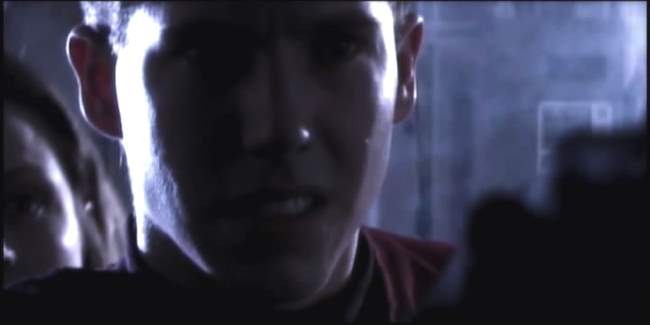
The Acting: The acting in Cl.One is certainly nothing to write home about. Jeff St. Clair as Derek Strombourg is really the only one who delivers a consistent performance. That said, there are very few clunkers either. Nobody truly embarrass themselves, and you never really get the feeling you’re watching a cheesefest trainwreck. While this isn’t exactly a ringing endorsement, keep in mind that this cast is almost comprised completely of amateurs. Not even the director had any experience prior to this shoot. While there were few clunkers, there was also distinct lack of emotional “umph” that really detracted from the overall experience. The stilted, uneven dialogue dialogue contributes to this in that it really doesn’t give the cast much to work with. Everyone was playing their parts but the performances as a whole came off as flat, which reflected poorly on an already slow-paced flick.
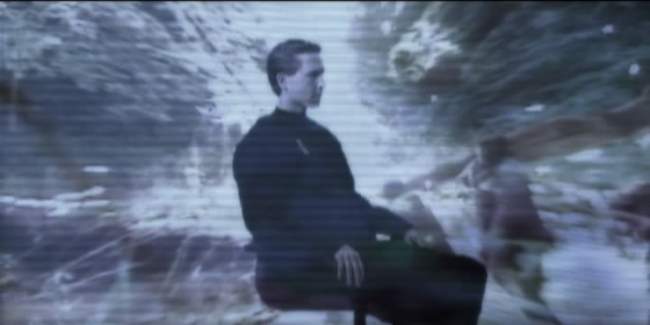
The FX: One of the best ways to cut corners on low-to-no budget science fiction projects is the selection of interesting locations. Cl.One excels in transforming seemingly ordinary locations into cool science-fiction settings. In all, fourty-eight Cleveland locations where used, including a nuclear power plant, a jail and Nasa locations. But perhaps the most interesting was the laboratory, which was created in a beer brewery. While one or two of the FX scenes look cheap (primarily the train sequence), the majority of the CG used in this Cl.One worked wonderfully. The FX and overall production values were generally what you would expect from a professional film, not a no-budget indie flick. Cl.One creates a look similar to Sky Captain and the World of Tomorrow, in that the entire film has been sent through digitized color filtering. While the overall look was professional, it served to drab-down the picture, which didn’t work well when combined with flat acting and slow pacing.
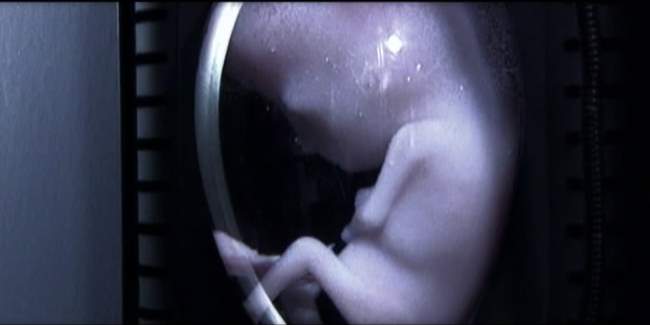
Blank Clone Bodies? One of the “take on faith” science points that Cl.One asks the viewer to swallow is the idea that they can make cloned bodies which are “blank” – meaning they have no soul, no memories and no personalities. The big challenge involves figuring out how to make these blank bodies get magically filled by finding the right matching genetic sequence to give life to a thousand frozen embryos. . All sorts of questions that might go through your head are all bypassed – why can’t the way that cloning today works still work in the future? Also, if they have all this expertise at genetic engineering to the point that they “know” the match they need, why can’t they modify the genetic code prior to uploading? Even more problematic, if they are transferring DNA sequences, why does the state of the person whom the DNA is from matter (Orin needed to be suicidal for his thoughts to not transfer to the clones)? You can ask those questions if you buy-in to the idea that clones can be made without souls or thinking, etc. This is an extreme version of the blank-slate approach, one which is nonsensical on its face, and one which they provide absolutely no rationale for in the narrative.

The Bottom Line: Cl.One has some terrific things going for it, but in the end, I like the background story of its production far more than I like the movie itself. Truly, I absolutely loved the “making of” featurette. That large segments of Cleveland pitched in for free to make this movie is a crowing achievement, one which should be celebrated. In orchestrating this dynamic, Jason Tomaric shows himself to be a true film making talent. And while the lighting and production values are high quality, the movie itself just doesn’t come together. The score is way too emotional and dominating when matched with the scenes, the actor performances and dialogue. The story doesn’t hold together, and the “twist” near the end makes you seriously question the character focus choices throughout the movie. On a positive note, the lighting and visuals were consistently interesting. Because of this and the background of the production, I would recommend Cl.One to anyone interesting in indie Sci-Fi flicks.
Movie Review By: SFAM
Year: 1984
Directed by: Michael Crichton
Written by: Michael Crichton
IMDB Reference
Degree of Cyberpunk Visuals: Medium
Correlation to Cyberpunk Themes: Medium
Key Cast Members:
- Sgt. Jack R. Ramsay: Tom Selleck
- Officer Karen Thompson: Cynthia Rhodes
- Dr. Charles Luther: Gene Simmons
- Jackie Rogers: Kirstie Alley
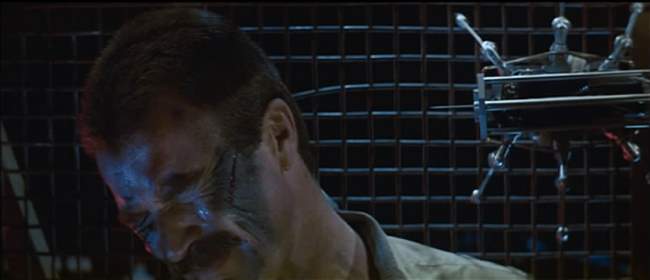
Overview: Sometimes cheese can be enjoyable. Michael Crichton’s movie, Runaway, is filled with too many straight-up Hollywood clichés to be taken seriously, but it’s still fun. Maybe it’s just because I’m a Die-Hard Magnum PI fan, or perhaps I love to see Gene Simmons’ evil glare. Runaway has some fun ideas, but the movie’s not great. It’s one of those movies where the bad guy can magically get anywhere and automatically knows everything. It is more fun than it deserves to be though.
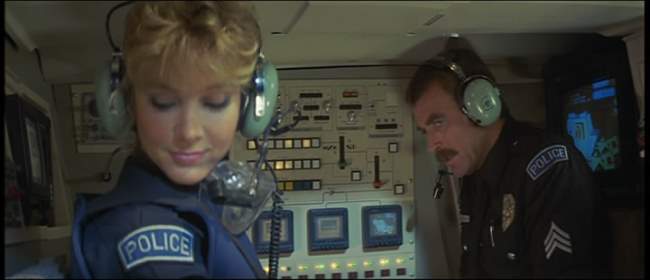
The Story: In near-future, society has taken full advantage of micro-electronics and robot technology. Many basic jobs, such as taking care of corn fields, are now carried out by robots. Robots even fulfill surrogate nanny roles for children stuck at home. In this world, Sgt. Jack Ramsay (Tom Selleck) is a specialist on disabling malfunction robots. Ramsay and his new partner, Karen Thompson (Cynthia Rhodes) get enmeshed in a series of incidents where robots have gone wild, sometimes with deadly results.
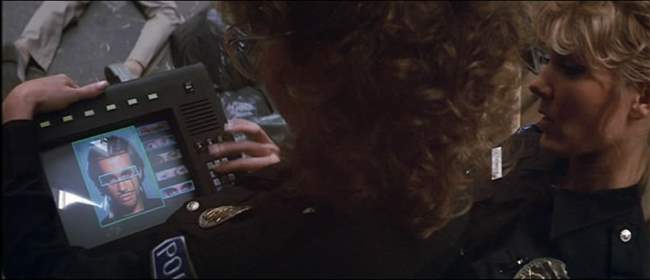
In investigating the faulty robots, they find that they have been modified with a special “assassin” computer chip that turns normal robots into man-killing death machines. The trail leads to Dr. Charles Luther (enjoyably played by Kiss rock star, Gene Simmons), and over-the-top evil genius who will stop at nothing to develop and sell these chips to the highest bidder. Ramsay and Thompson stop Dr. Luther by intercepting a chip delivery from his girlfriend, played by Kirstie Alley, and capture Luther’s chip design template for making new copies.

As the plot thickens, Dr. Luther brings out his toys. The most impressive gadget which the movie is most known for are mini-spiders that can jump 6 feet in the air, and deliver shots of acid. Luther also has heat-seeking bullets that can be targeted to an individual body heat profile, and mini-homing bombs on wheels called “lock-ons.” Things get tense when Luther kidnaps Ramsay’s kid to exchange for the chip template.
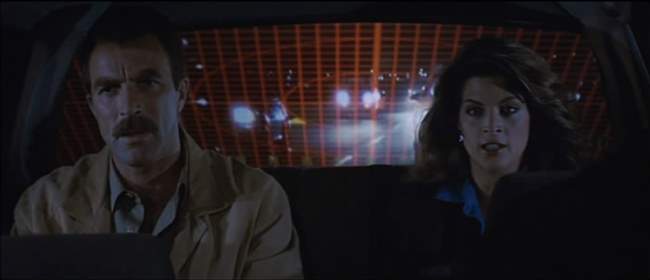
The Acting: The acting is nothing special in Runaway, and certainly lacks originality in any of the assigned roles – virtually every character is cookie cutter Hollywood fare. Tom Selleck basically plays his Magnum PI character, so if you like that guy, you’ll probably like his performance here. Cynthia Rhodes plays a shallow but cute sidekick who wants nothing more than to get it on with Selleck. Kirstie Alley’s role consists mostly of looking hawt. With that said, Gene Simmons is the really fun one to watch. All he really does well is “look evil” but he does this so well! This coupled with the fact that Simmons’ character is almost magical – he always knows where everyone is, and can infiltrate any location including a busy police station to log on to Ramsay’s computer with virtually no disguise. Again, we’re not talking high quality here, but it is fun.
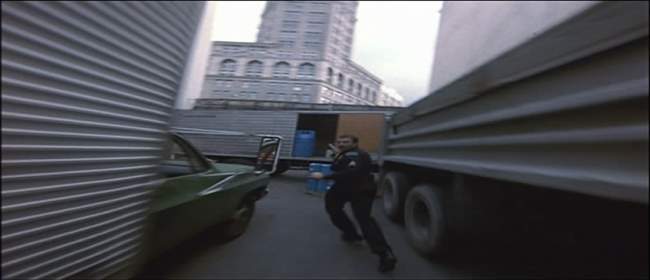
The FX: Runaway provides us with a number of low-budget cyberpunk toys, but probably the best effect employed was the use of the fish-eye lens to give us the perspective of the missile bullet. This simple camera effect makes the heat-seeking bullet far more believable than it should. But it’s the spiders which everyone recognizes. For some reason, these seemed far more believable to me when I watched this movie in the 80s. Now, they just sort of seem to sit there and wiggle. Still, when watching the ending sequence in Matrix Revolutions, where Neo walks through the tunnel with the high-quality CG spider-bots traveling everywhere, I was reminded of Runaway. So in that sense, Runaway’s toys have outlasted the movie itself.
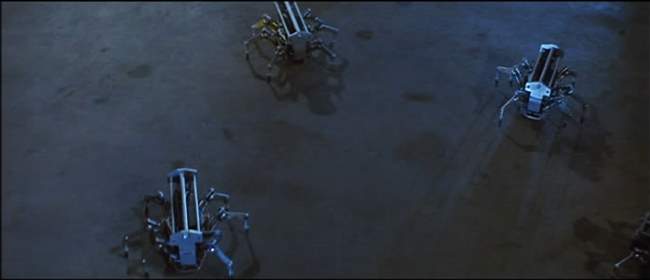
Evil Chips: I’m not really sure what this even means, but Runaway is predicated on the idea that “assassin” chips can be made. These chips provide an alternate instruction set which appears generic enough to work on virtually any robot. In looking at this, the idea reeks of Hollywood cheese. Wouldn’t it be cool though if someone could design an instruction set that could self-organize its commands based on its environment? I suppose Java does this in some ways in that its platform independent, but robot independent seems a bit more complicated.
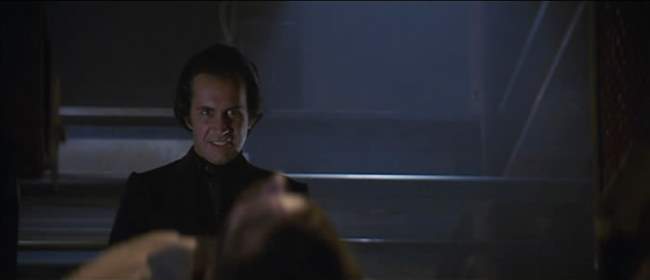
Dr. Luther is just another Dr. Evil: It’s amazing how a character can change the world of film. Ever since Austin Powers’ Dr. Evil character came onto the stage, it’s virtually impossible to take incoherent evil guys seriously. The moral of this story is had Dr. Charles Luther just paid off his henchmen, he would have escaped scott free. But since he had to come up with craaazy deaths for them, our hero had to come to the rescue.
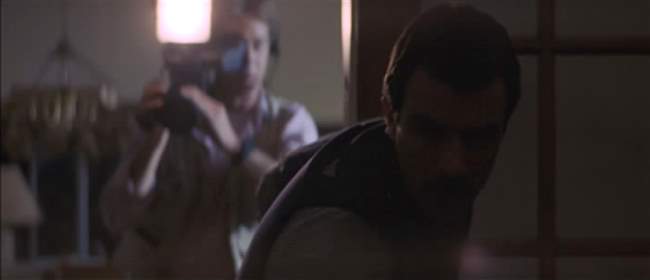
Full and Free Access by the Newsies: In Runaway’s future, the news organizations have the right to wherever they want, whenever they want. So much so that they’re allowed access during a police operation to save an infant from a crazed robot. This comes off as being fairly silly in the movie, as its hard to imagine them ever getting this type of access. This is more an indication of the perception folks had of news organizations in the 80s. How time changes things. Now the perception is that news organizations pretty hang out to wait for their stories to be hand-fed. They still excitedly arrive at standoffs and the like, but outside of a few brave souls who prowl the streets outside the green zone in Iraq, it’s hard to imagine news organizations today even bothering to investigate the most obvious of events.
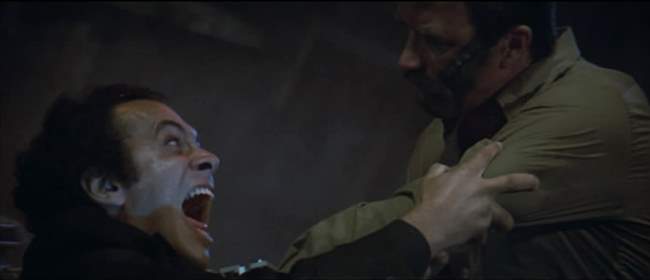
The Bottom Line: One has to wonder how a decent story teller like Crichton ends up taking some interesting ideas on technology and society and embedding them into a cookie-cutter Hollywood storyline. Things certainly happen in the production so who knows. Watching Runaway, you get the feeling that this should have been a better flick. But while the movie isn’t great, the spiders are fun, as is Gene Simmons’ glare. And if you’re a Magnum PI fan, chances are you’ll like it even better than one of the weekly episodes.
Movie Review By: Dan Swensen
Year: 1981
Directed by: Michael Crichton
Written by: Michael Crichton
IMDB Reference
Degree of Cyberpunk Visuals: Low
Correlation to Cyberpunk Themes: Medium
Key Cast Members:
- Larry Roberts: Albert Finney
- Cindy Fairmont: Susan Dey
- John Reston: James Coburn

Uneven, satirical, and oddly prophetic in its own half-baked way, Michael Crichton’s 1981 film Looker takes place in a terrifying universe of glamour, dehumanization, corporate deception, and Susan Dey hooking up with Albert Finney.
SFAM NOTE: We welcome new reviewer Dan Swensen, who also runs a terrific Sci-Fi blog called the Dimfuture.net. If others are interested in joining the review team, please post a message in the review forum.
Overview: The year is 1981, and pudgy, befuddled plastic surgeon Larry Roberts (Finney) becomes involved in a mystery when one of his models, dissolved in tears, arrives in his office raving hysterically about mysterious people trying to kill her. Hours later, the model inexplicably falls from the window of her high-rise apartment, and evidence of foul play points to Roberts himself. Justifiably concerned, Roberts begins playing amateur detective, teaming up with his patient (the vapid and insecure Cindy Fairmont, played by Susan Dey) to find out what’s really happening to these models, who seem to be dying off in droves shortly after visiting Roberts’ office to be “perfected.”
Mostly relying on the incompetence of the antagonists and the near-complete apathy of the cops, Roberts eventually tracks the clues back to a company called Digital Matrix, a computer graphics and advertising firm that specializes in creating digital replicas of top commercial models. While these models are given lucrative contracts in exchange for their digital likenesses, they seem to mysteriously die shortly thereafter, their handsome royalties left unpaid. It doesn’t take long for Roberts to figure out that Digital Matrix is duplicating these models, then killing them off, as their “digital doubles” will do their job better — and for free.

Machines and Misogyny: In an age where digital replacement and enhancement of actors is now extremely commonplace, Looker seems both surprisingly relevant and woefully dated at the same time. Penned in by Hollywood’s desire for complete perfection, the models of Looker fret over millimeter-sized flaws, consumed with self-loathing over even the slightest imperfection. As the story progresses, the audience finds this to be more than mere vanity — in Crichton’s world, Digital Matrix has reduced human behavior to a set of algorithms, able to determine (and manipulate) the focus of a viewer’s attention with ultimate precision to maximize product exposure and desire.
Because these manipulations require inhuman accuracy, the models themselves soon become not only obsolete, but liabilities to the company. The theme of dehumanization — the models looked upon by the corporations, and themselves, not as human beings but commodities to be used up and thrown away — is very strong in the first half of the film, underlined by a casual misogyny that may or may not have been intentional (it was 1981, after all).

In addition to the prophetic “digital doubles” of the film, Looker’s most science-fiction invention is the L.O.O.K.E.R. device (short for Light Ocular-Oriented Kinetic Emotive Responses), a “light gun” that stuns and paralyzes the target using light. Anyone exposed to this weapon experiences a sort of “missing time” as they stand paralyzed, allowing the weapon’s user to move around, invisible and undetected, for short periods. Digital Matrix uses the device to cover their tracks, making the models’ deaths appear as suicides.
While Looker is more than a bit plodding at times, the film’s use of this device is undoubtedly the most clever effect in the film, as characters find themselves losing time without knowing how or why. (It’s also worth mentioning that the L.O.O.K.E.R. device is the movie’s only real special effect, and provides the film’s most interesting visuals.) The L.O.O.K.E.R. device is a neat little concept, one I wish could have gotten better treatment in a better film.

The Bottom Line: Unfortunately, Looker is a movie with a few good ideas that don’t quite survive the runtime. The last half-hour of the movie is an extended game of “humorous” cat-and-mouse in which the heroes and villains chase each other through a virtual landscape of digitized commercials — the best of which is a genuinely macabre moment featuring digitized kids complaining about their breakfast cereal as a real human lies dead on the prop kitchen table.
While these scenes are mildly funny on a multitude of levels (the style of commercials, for all their “digital” glory, are more akin to something out of the Fifties than anything out of science fiction), they’re out of tone with the rest of the film. Albert Finney is no action hero, and doesn’t even have the charisma necessary to be a good everyman. Susan Dey’s character is too insecure and flat to be anything but an object of pity, and James Coburn’s turn as the villain, while passable, is too brief to be interesting.

A mustachioed Eighties thug gets a taste of the L.O.O.K.E.R. device.
That’s not to say that the film can’t be enjoyed as good cheese, however — there are some amusingly inept moments (watch for the car “crashing” into the fountain), and the few special effects are decent enough. Overall, Looker is probably more interesting as a historical piece than as a thriller — though it’s dated badly on a number of levels, the ideas of dehumanization and artifice that it puts forth were, for 1981, surprisingly forward-thinking. It might also be interesting to note that Looker made the first real attempt at a realistic CGI character, as well as the first movie to used 3-D computer shading.
After its release in theaters, Looker haunted the bleak hinterlands of early Eighties cable television for awhile (probably sandwiched somewhere between showings of Krull and The Entity), and is out on DVD now. Oh, and if you care about that sort of thing, Susan Dey is naked in it.
-Dan Swensen
Movie Review By: SFAM
Year: 1994
Directed by: Peter Hyams
Written by: Mike Richardson & Mark Verheiden
IMDB Reference
Degree of Cyberpunk Visuals: Medium
Correlation to Cyberpunk Themes: Medium
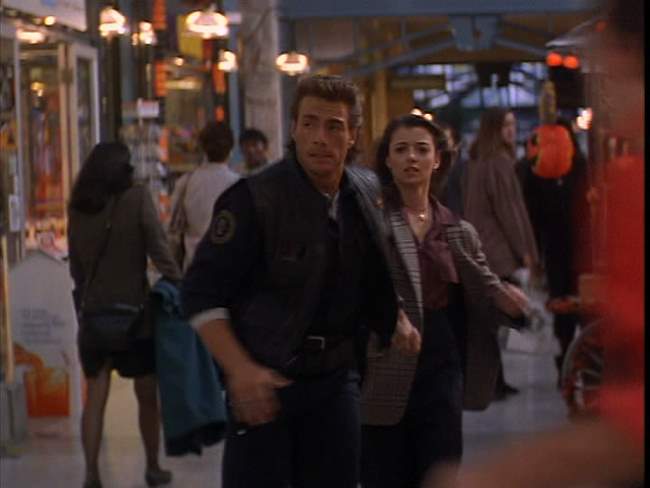
Overview: In the annals of cheesy time travel movies, few are known better than Timecop, which cleared over 100 million in world wide box office gross. Starring martial arts star, Jean-Claude Van Damme, Timecop has decent but low-budget FX, a fairly shallow notion of science and time quandaries, but does provide a face-paced cyberpunk action-thriller with decent amounts of butt-kicking and gun fighting. Like many of his movies, Van Damme plays more than one version of himself – in this case, he plays himself 10 years into the future.
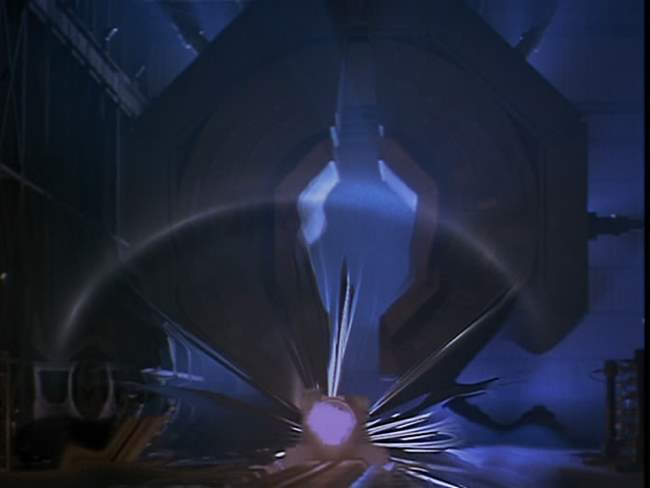
The Story: In the near future (2004), time travel has now become possible. Unfortunately, there is a very real danger that going back in time will alter the present. To protect against potential abuse, a special police outfit called the “Time Enforcement Commission” is established to monitor and enforce time travel concerns. Max Walker (Van Damme) is selected for an interview to join. Unfortunately, events in the future have already changed his current circumstances, which lead to the death of his wife, Melissa (Mia Sara).
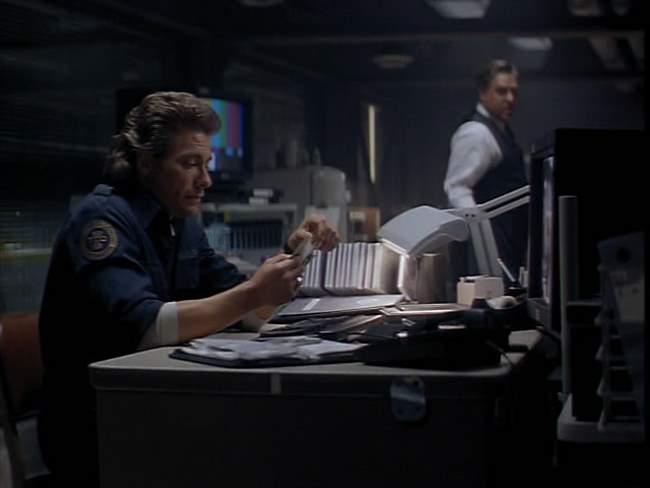
Ten years into the future, Max, still working at the Time Enforcement Commission, goes back in time to stop his former partner from attempting to splurge on low-price stocks in 1929 that will be worth a fortune in the future. In stopping his partner, Max uncovers a larger plot of time travel tampering that implicates a sitting Senator of the United States (Ron Silver). As Max starts to investigate, the bad guys begin significant tampering with the timeline. Upon return from one of Max’s fact finding trips, he sees that the future has been significantly altered, and the police force is being decommissioned.
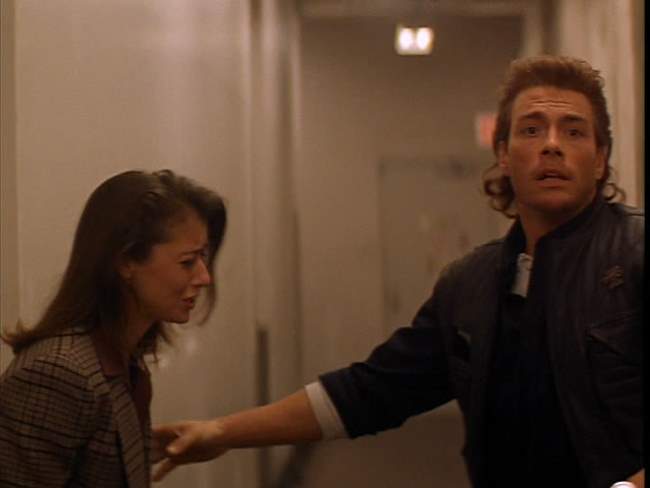
Max convinces his former friend (the time altering apparently has affected their friendship) and police Commander, Eugene (Bruce McGill), to send him back in time to fix the damage done to the timeline. In doing so, Max has an opportunity to go back and save his wife. Things come to a head when Max and the Senator meet face to face (both current and future versions of each).
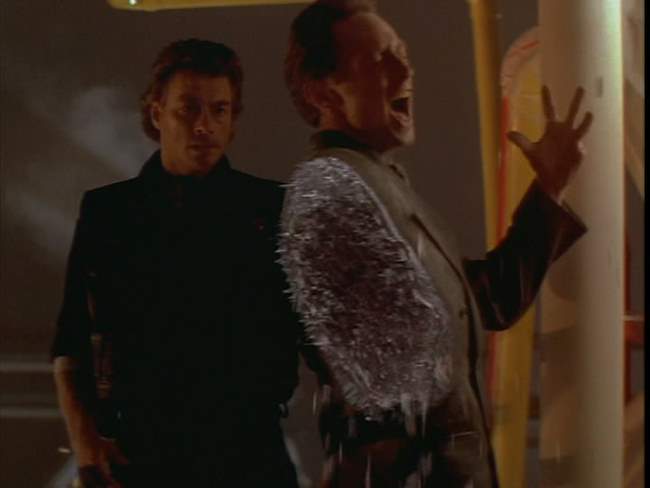
The Action: The reason you want to watch Timecop is primarily for the fast-paced action sequences. We get lots of Van Damme kicking, along with a nice smattering of gunfights, all in interesting locations. As a downside, only one or two of the bad guys put up a decent fight. So many of the action scenes involve Van Damme just wailing on “red shirt” henchmen.

The FX: The FX for Time Cop worked at the time, but now look somewhat dated. There are quite a number of time portal effects, along with a few burning and “people plasma” shots sprinkled throughout. The set designs are pretty decent, most notably the time portal device, which has a nice dirty, low-tech feel to it. Still, I wish they had done more with the time travel machine, which looks and works like a rocket version of Back to the Future’s flux capacitor.
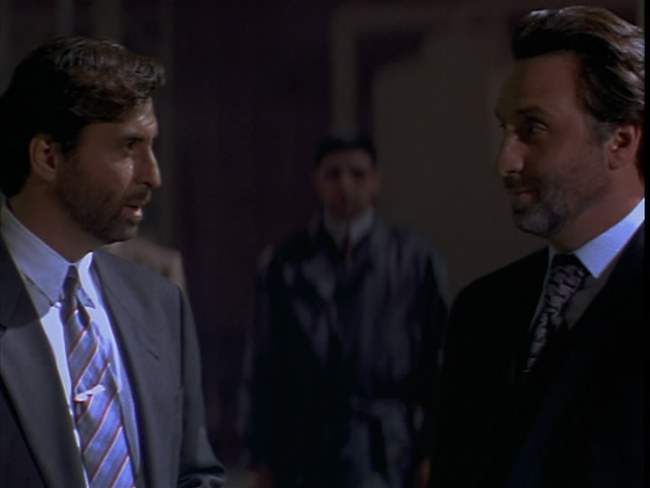
The Acting: Considering this is a Van Damme movie, the acting is somewhat better than expected. Van Damme is his same self, which is to say “rather wooden.” But Mia Sara, Ron Silver and Bruce McGill turn in decent performances – certainly decent enough to work with the fast pacing.
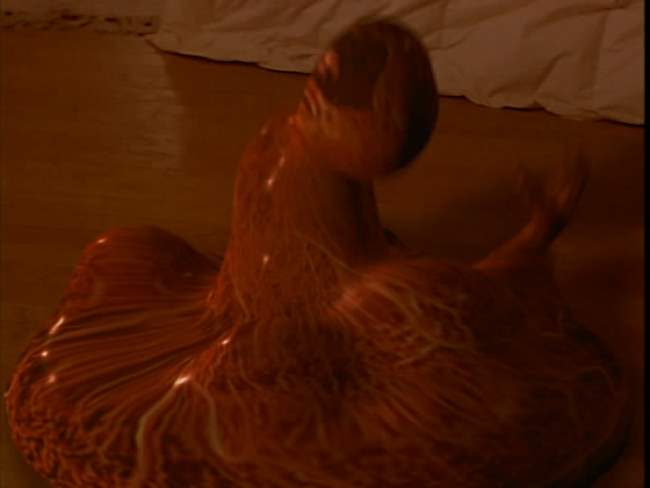
Problems with Time: Timecop really can’t be used to spark interesting discussions on time travel. The questions with how and why things work are too numerous and problematic to engage in interesting discussions. Somehow, they are able to determine if someone has violated time, and can go and stop them, but they don’t seem to be able to go to the same place more than once – why? The same two people cannot occupy the same space – why? What happens if a guy is 80 years older and goes back an visits himself as a small child? Virtually none of the same cells will remain from the child – certainly no skin cells (nor would they for 10 years out, as was the case for the poor Senator) – so how does this constitute occupying the same space? When Max Walker spends the day jumping through time, the future is modified – and he seems to have lost 10 years worth of memories. What happened to the version of Max that lived those 10 years? Did he disappear, or has he simply not gotten home from work yet? One gets the sense that Max is just jumping alternate versions of the present – each one that he created – but the ideas are too shallow to make any real sense of this.
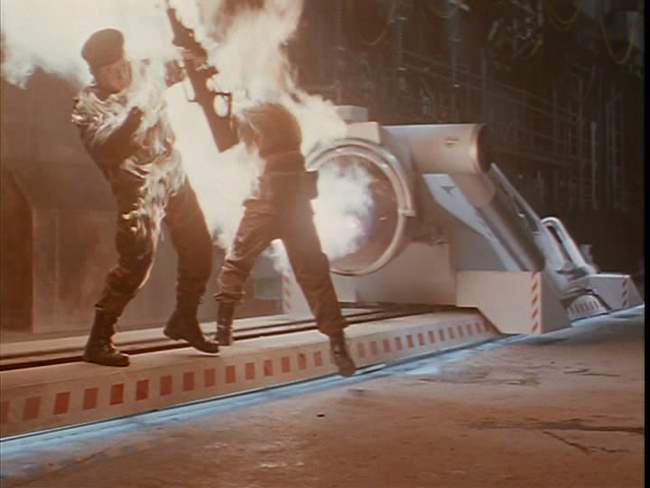
Bad Guys Have Limited Imagination: Like many bad guys, the imagination of the evil doers in Timecop is severely limited. Time travel is used to go back and engage in bank heists, make stock purchases that pay out 70 years in the future, and so forth. If one really had this technology cornered, it seems that there would be far better ways to generate income. With just an ounce of imagination, one could come up with a myriad of more interesting ways of generating power and influence than petty crime. What about a recorded interview with Jesus Christ? One would think this might generate lots more power and income than knocking off a confederate wagon train shipping small quantities of gold. Instead, the extent of Senator McComb’s ambition is to get rich, kill off potential enemies and then steal the presidential election.
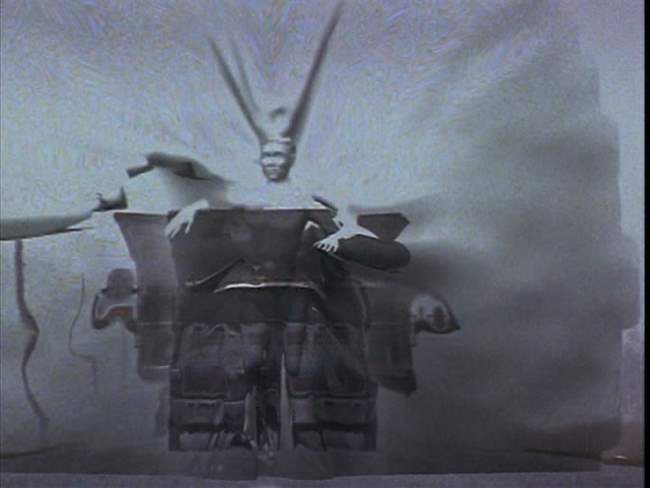
The Bottom Line: Timecop is an enjoyable movie assuming you turn your brain off prior to watching. This approach generally works as the fast-paced nature of the movie serves to stop you from noticing too many issues. The action is good and the FX are passable, so if you want to kick back and enjoy some Hollywood martial arts wrapped up in a cyberpunk time travel flick, give it a go. I will say though that the quality of the DVD is horrid - so much so that I’m docking a star from my review. It’s got a lousy transfer, no extras, and is in full screen only. Common Universal – fix this!
~See movies similar to this one~
Movie Review By: SFAM
Year: 1986
Directed by: Shigeru Izumiya
Written by: Shigeru Izumiya
IMDB Reference
Degree of Cyberpunk Visuals: High
Correlation to Cyberpunk Themes: Medium
Key Cast Members:
Lead Researcher (Male): Takichi Inukai
Lead Researcher (Female): Rikako Murakami
Third Researcher: Shigeru Izumiya
Guernica (Android): Mari Natsuki
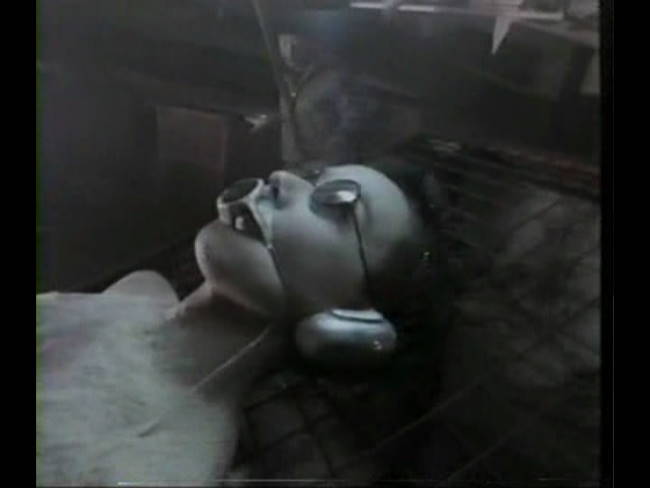
Is there life without death?
Overview: Here I yet again delve into the world of the experimental extreme Japanese Cyberpunk – this time to watch Death Power (Desu pawuda in Japanese), a movie Glam Creature discovered for me. Death Powder is a very low budget, mostly incoherent extreme Japanese Cyberpunk film with some occaisionally very interesting visuals. I probably would have liked this movie more had I obtained either a decent transfer or full subtitles. Unfortunately, the only place I could find this at the time was on LostSilver.com, a site that presses public domain movies to DVD-R format. All the main characters had appropriate subtitles, but the vast amount of mumbling in this film (mumbling usually occurred ultra-bizarre situations) was only subtitled in Chinese. The transfer was so bad that in some scenes the screen appears pixilated.
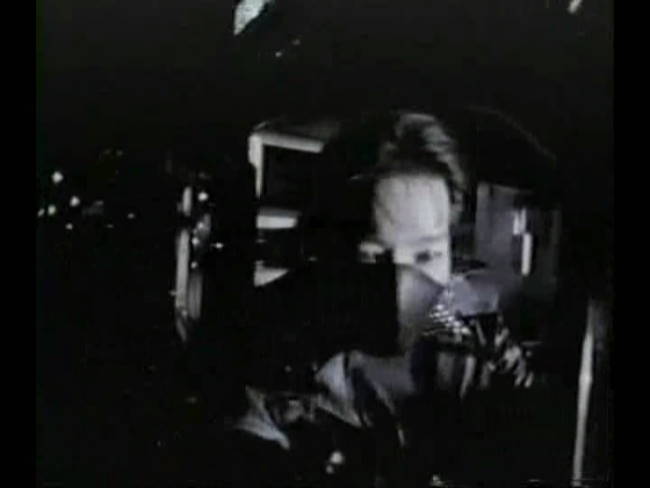
The Story: In the very near future, a group of three researchers has captured a very special android named Guernica (Mari Natsuki), and have brought her to a deserted warehouse, and have tied her to cot, with a protective covering over her mouth. One researcher (Izumiya) is left to guard the Guernica, but appears to be slowly going crazy. Two of the researchers, a guy (Inukai) and a girl (Murakami) apparently have just escaped (presumably from some fallout after capturing Guernica) and are on their way back to the warehouse. Murakami tries calling Izumiya and discovers that something is wrong.

They proceed carefully into the warehouse where they discover that Izumiya has gone crazy and is now trying to kill them. Izumiya makes it to Guernica, who suddenly sits up and blows dust all over Izumiya. From there, the movie turns extremely surreal. Guernica’s body slowly disappears into dust, while Izumiya’s face starts to expand dramatically (in a very low-budget sort of way), while Izumiya rips his hand off and Inukai shoots Izumiya with a futuristic looking gun. Things settle down with Izumiya off hallucinating, while Izumiya has somehow captured and tied Inukai to Guernica’s metal cot. She gets free and beats Izumiya to a pulp.
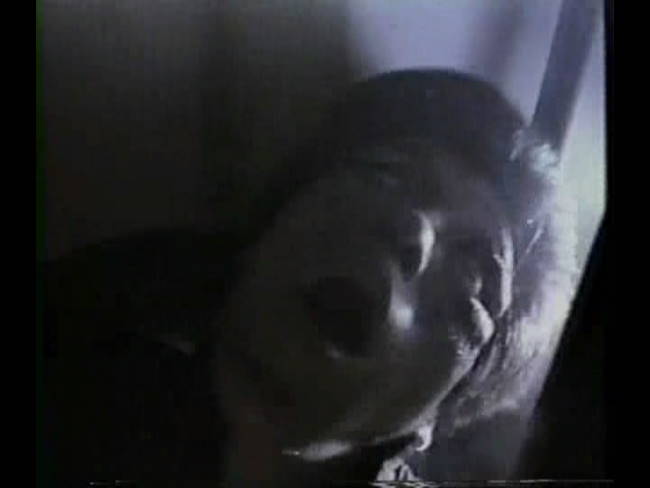
Sometimes death is the ultimate statement.
Meanwhile, Inukai’s hallucinations have provided him omniscience. Inijai proclaims, “”I understand the secrets of the flesh.” He sees Guernica’s origins and the ongoing struggle with the scar people, who are people who’s flesh is slowly decaying on their bodies. Things get even weirder from there with visuals of massive globs of oozing puss creatures with eyes, an incoherent video montage, a fight with the scar people, and in the end, we find a very bizarre looking monster sitting in a vast setting of emptiness.
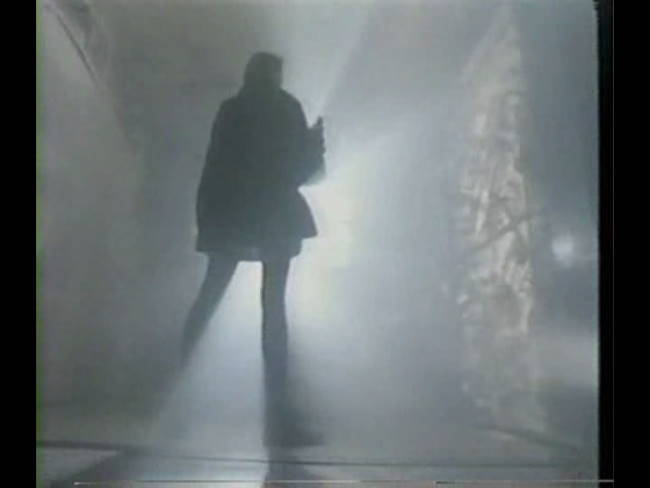
What The Fuck is This Film About??? I fully acknowledge that Death Powder is incoherent enough that attempting to interpret it will potentially lead to nonsensical ambiguity. Unlike others like Tetsuo, which CLEARLY has a point even though many claim are incoherent, this film may not simply hold together well enough to have a clear point. That being said, after two watches, it appears that the death powder is an allegory for technology’s insidious and pervasive destruction of mankind. That Android chick’s name, Guernica, after Picasso’s famous painting, gives us the clue. She is the embodiment of humanity’s destructive tendencies, and like the painting, her ultimate impact is seen with dead, injured, dismembered and torn bodies. That Geurnica is created by a rock star playing an electric guitar indicates that our technology enabled modern culture is ultimately to blame. A bastardized version Christian forbidden fruit analogy also is at play here in that a woman (android) possesses the forbidden knowledge, and humanity tries to access it by capturing her and covering her mouth. The implication is that they hope to possess the knowledge without suffering the consequences.
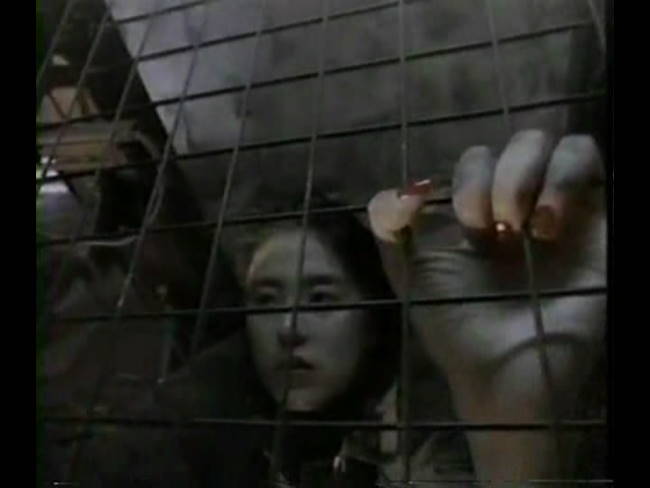
The other aspect that Izumiya seems to explore is the nexus between life and death. Death Powder explores competing ideologies in examining this question. Initially, we are told that “Life without flesh is death.” The researcher, now fully infected and potentially dead, but still thinking (meaning his flesh is dead), responds to this thought with the following:
There is no death without life. There is no Answer to this Madness.
Heaven exists within my body…dead. But Hell…Hell is everywhere!
To which, the Android, Guernica responds, “Is there life without death?” From an android’s perspective, this is probably a VERY interesting line of questioning. If you are able to think, does this not imply you are alive? But if you have no flesh – doesn’t this imply you cannot die? This is of course completely at odds with the original statement. When we include the scar people – a faceless gang of humans losing their flesh – as those espousing that life without flesh is death, we are left with a losing struggle where living humanity (flesh) is supplanted by our technological monstrosities our culture creates. In effect, Izumiya is espousing that humanity slowly dies as our culture is merged with technology. In the end, all that is left is this zombie-like monstrosity that is neither alive or dead, but definitely isn’t human.
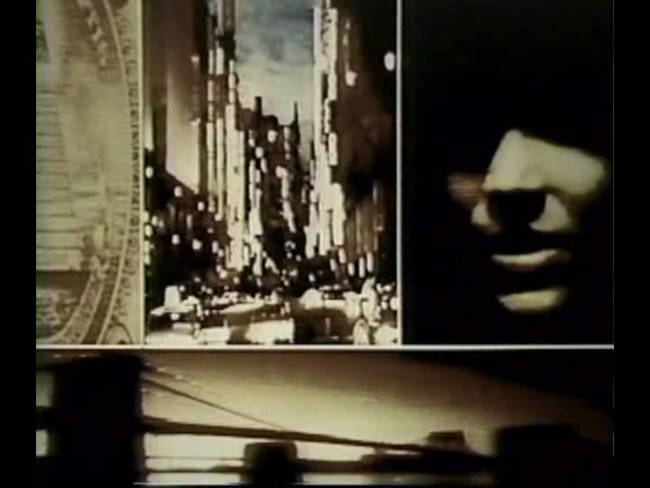
Disconnected Bizarre Video Montage: At about three-fourths through the 62 minute movie, Death Powder breaks into a ten minute plus video montage segment. This occurs after the death powder-enabled android chick states something to the effect that there are far more people to infect, so she must hurry. I’m guessing this is supposed to be Guernica’s Destroy the World tour. This would work except that when its over, we are brought right back to the warehouse, this time to await some workers who are lured into the pit of horrors. In ending it as such, the purpose of the montage seems to disappear. In the end, we are left with the idea that director Shigeru Izumiya had also developed this cool video montage footage, and wanted to include it somewhere. It does look pretty cool though.
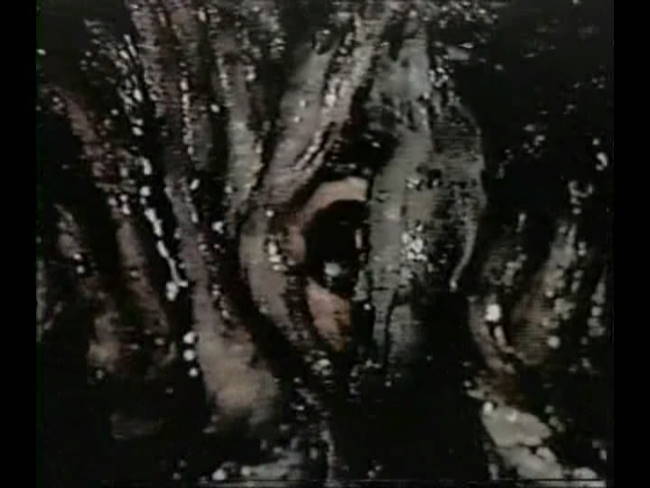
Life without flesh is death.
The Visuals: Like many experimental films, Izumiya literally throws in every kind of camera technique available. We get tons of perspective shots, multiple exposure shots, different overexposed lighting shots, completely strange camera angles (like a sideways up-above running shot), all wrapped up in a myriad of disturbing visuals. Whether we get coherency or not, Death Powder is certainly creative. I really wish I had been able to obtain a better copy of the film, as I’m afraid the color is washed out on Lostsilver’s public domain version (although I don’t know – perhaps this is intentional). This leaves the film with a very washed out, almost (but not quite) black and white look.
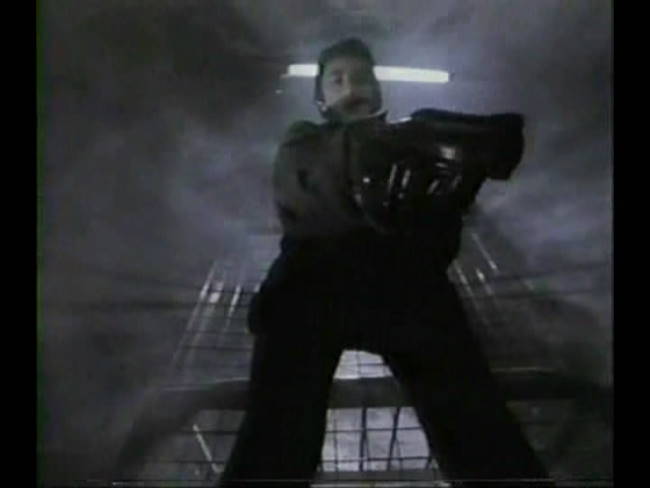
The Sound: Perhaps Death Powder’s best strength is in its sound effects. Izumiya continually barrages the audience with a cornucopia of industrial/techno cyberpunk sounds. We get various low-toned keyboard pieces combined with strange and eerie sounds of all types and textures. If I had to guess, I’d say the majority of the time spent on producing Death Powder was working with the sound track – it’s by far the most polished aspect of the movie. This may not be all that surprising considering Izumiya got his start composing for Japanese Cyberpunk director Sogo Ishii on Crazy Thunder Road.
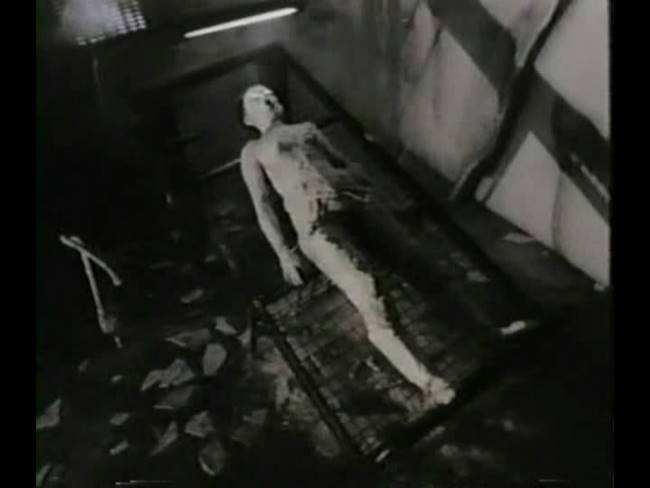
The Bottom Line: I wonder if I’ve become jaded since watching a number of these extreme Japanese Cyberpunk flicks. Many comments about Death Powder indicate that people were blown away by the visuals and have never seen anything like this – some to the point of even having nightmares about it. If this is your first, or perhaps even second experience in delving into extreme Japanese Cyberpunk movies, than perhaps Death Powder comes off much better. However, as much as I love the experimental visuals, this movie clearly could have been put together better. There is a lack of crafting in Death Powder which negatively impacts the movie-watching experience. Still, Death Powder, while incoherent, is at least unique, creative and interesting, so there’s certainly something worth watching here. It’s for this reason that I’m giving it 5 stars instead of 4. I really wish I was able to get a better transfer of this, but even if I had it, I still doubt I’d be giving it more than 5 stars.
~See movies similar to this one~
Movie Review By: SFAM
Year: 2005
Directed by: Michael Bay
Written by: Caspian Tredwell-Owen, Alex Kurtzman & Roberto Orci
IMDB Reference
Degree of Cyberpunk Visuals: High
Correlation to Cyberpunk Themes: Medium
Key Cast Members:
Lincoln Six Echo/Tom Lincoln: Ewan McGregor
Jordan Two Delta/Sarah Jordan: Scarlett Johansson
Merrick: Sean Bean
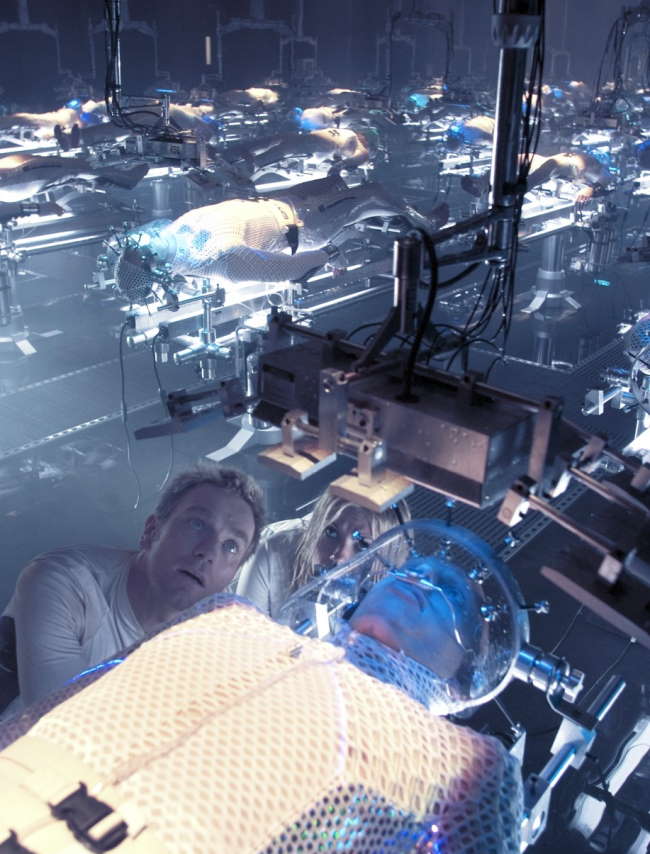
Overview: The Island is straight Hollywood fare from the get go. In this summer bubble gum scifi-action romp, you’ll find few original ideas here, or even a coherent plot, but you will find loads of awesome visuals and even more action scenes and explosions. Vast amounts of money went into creating some rather incredible action sequences. Unfortunately, with all the thought devoted to creating those sequences, there apparently was little left for the story itself. Still, Scarlett Johansson looks absolutely gorgeous in The Island, and Ewan McGregor works as a leading man.

The Story: In the future, the desire among the rich and famous to live for ever dominates their existence. Along comes Dr. Merrick (Sean Bean) who founds the Merrick Corporation to meet this market need. The Merrick Corporation has (supposedly) found a method to take a person’s DNA and clone all of their organs within a gelatinous blob that maintains a persistent vegetative state. Unfortunately, they were never able to make this work, so instead, the Merrick Corporation broke all the laws and went with straight cloning of their human sponsors. For a cool 5 million bucks, sponsors can buy an insurance policy to ensure they always have a perfect set of organs that can be harvested to save them from whatever malady arises.
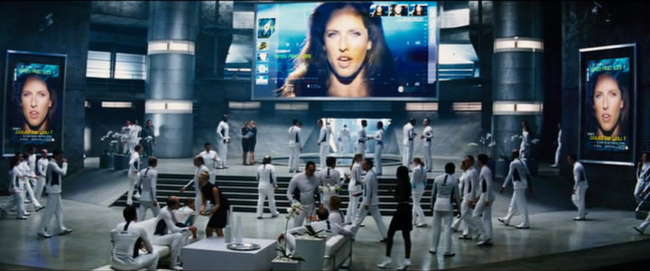
To keep the clones under control, Dr. Merrick constructs an alternate reality where a contaminated world has killed everyone except for a few fortunate souls who were rescued and placed into a special set of buildings. They have also saved an Island, which is now the only place on earth where people can live without dying. Now all the clones await their turn in the lottery, which, if won, supposedly means they will be able to go to the Island. In reality, the clones are “selected” when their sponsor has need for one of their body parts. From their diet to their associations with others to their urine output, every aspect of a clone’s life is monitored. THX-1138’s surveillance society, right down to the oppressive white, is omnipresent in The Island.
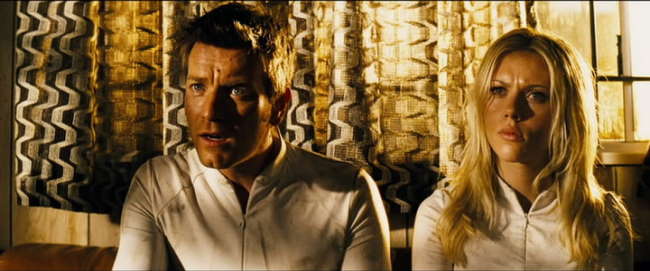
Lincoln Six-Echo, played by Ewan McGregor, is a clone who starts questioning his surroundings. He eventually gets out (through a completely idiotic plot point) and realizes that that those who leave to go to the Island are in fact being murdered. He quickly goes back to get his close friend, Jordan Two-Delta (Scarlett Johansson) who just yesterday was selected to go to the Island (her sponsor is dying from wounds suffered in a car crash). Together, they make a break for it, but are pursued by (we are told) a crack-group of ex-special forces agents led by Djimon Hounsou. With the help of a low-level employee (Steve Buscemi) that Lincoln Six-Echo befriended, Lincoln and Jordan make for Los Angeles in an attempt to find Lincoln’s sponsor to discover the truth. From there, The Island turns into a high-tech, futuristic chase movie, with continually larger explosions and action sequences dominating screen. I won’t spoil the ending for you, but suffice to say this movie is as predictable as they come.

Michael Bay’s Approach to Story Telling: It’s pretty clear that director Michael Bay doesn’t plan movies like most directors. He seems to pay FAR more attention to the visual progression than he does the actual dialogue. The narrative in Island, like most of his movies, simply doesn’t hold together. To buy it, you have to accept all sorts of inane action on the part of the characters. Michael Bay seems to construct his movies via storyboards alone – for instance, he knows that in the end, the hero and the bad guy need to fight on a high-tech, scary looking bridge with explosions going on in the background – he is far less concerned about the rationale that brings them together. In watching it, the Island is one of those rare movies that is actually more coherent if you turn off the sound. The story you make up to go with the visuals will almost certainly make more sense then some of the plot points Bay provides.
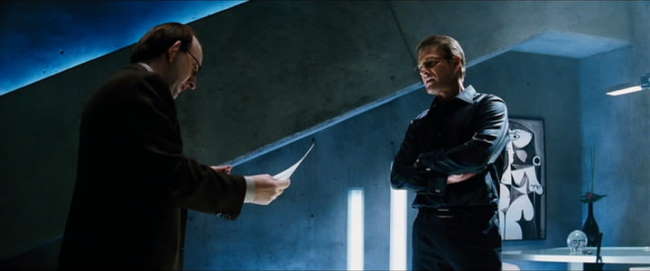
I don’t even mind that we have to accept that two clones, three and four years old, are able to outwit an entire platoon of ex-special forces personnel, or that they “magically” assume all of their cloned person’s skills (like riding flying motorcycles). I can even accept that a supervisor on a regular basis, gives a clone a key that gets him to the outside world to save the supervisor from running errands, or that the the police regularly park their squad cars in the middle of an intersection and then don’t look for broadsides, but some of the basic plot stuff really does bother me. In the Island, the cloning is a HUGE secret that implicates the entire corporation into illegal action, but none of the investors, including the Defense Department which as spent 120 Billion on this “technology,” ask any questions. Even more incredible, none of the hundreds, if not thousands of low-level employees have ever consider spilling the beans. Instead, they are so closed-mouthed, they don’t even tell their family members. Killing is cool for them, as long as they get to keep their meager paychecks. This is just one example – far worse are the ending plotlines, which have our heroes assuming that top-notch special forces personnel wouldn’t search them for weapons even after they’ve shot people (lucky for them, the special forces personnel complied), that hired thugs would hang out and watch their boss go mono-a-mono with the hero vice wasting our hero, and that the boss himself, up in the comfort of his office, would be able to make it to the hero far quicker than any of his hundred thugs who’s job it is to enforce the peace.

Product Placement Gone Wild: It’s kind of refreshing to know that in the future, all dehumanized clones have to wear Puma shoes and clothing, drink Aquafina, serve Ben & Jerry’s Ice cream to kids, model for Calvin Kline on billboards, play Xbox, seek out MSN Search as a phone book, conduct their slave work on Apple computers, steal American Express credit cards, snag rides on Mac Trucks, wear Monza watches, and look longingly at Michelob Light beers. And of course, EVERYONE will be driving either Cadillacs or Dodge Magnums in the future. The Bond movies, where you expect significant product placement, don’t hold a candle to the monstrosity that is The Island. Not only do we get an obscene number of product placements, the on-camera product “lingering” that Mr. Bay engages in is almost criminal. I felt like I should have gotten a discounted ticket due to the myriad of embedded commercials. It’s rather amazing if you think of it – that almost 70 years into the future, all these companies will still be using the same logos they use today. I must say though the product placements are very memorable – they make be both remember the product and more importantly, they instill in me the STRONG desire to never buy these products again, as I now associate these brands as contributors to fucking up my movie watching experience.
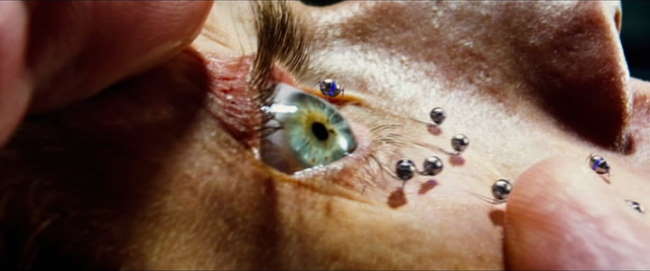
The Visuals: While I’ve bashed the Island’s plot, Michael Bay certainly deserves a lot of credit for delivering some pretty cool cyberpunk visuals. The clone development labs look pretty darn cool. Additionally, Michael Bay continually composes shots displaying wonderful color panoramas. We get gorgeous yellows and blues in a variety of textures and settings. In scene after scene, it becomes clear that while Bay isn’t too concerned about the dialogue or narrative sequences, he’s intimately involved in the look. In some cases though, the visuals, while impressive, make absolutely no sense – the worst example being the weird eye-nanobots that are needed to take pictures of the brain activity. That its necessary to have metal insects entering the eye in order to take a brainscan 70 years into the future strains credibility far past the point of reason – even worse, the brainscan cannot be processed until 48 hours!
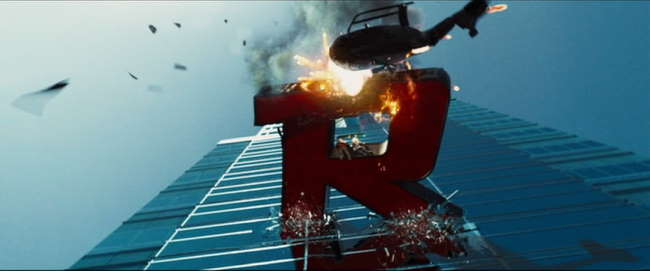
The Action Sequences: Michael Bay is known primarily for his outrageous and visually impressive action sequences. He does not disappoint in the Island as the action is consistently top notch. We get awesome explosions, incredible chase scenes and lots of gun fire and fight sequences, all with wonderful camera angles and high quality positional surround sound. If there’s one reason to definitely not miss the Island, it’s the action sequences. Michael Bay may not be a great film maker, but he and his crew are genius at constructing creative, eye-poppingly tense action.
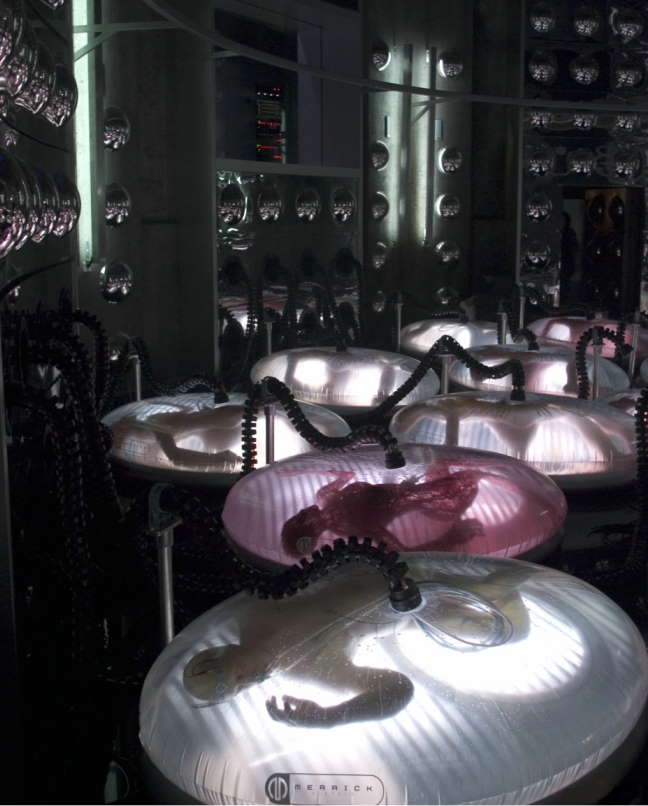
The Bottom Line: If there was one change I would make to the story, I would have suggested they had done away with the illegal nature of cloning (the second change would be to eliminate the magical memory transferral that happens between clones and sponsors). The Island would have worked far better if it portrayed a world were society as a whole had decided that cloned people were property. Instead, the Island practically ignores this question. But while I have a hard time suspending disbelief for the plot the Island provides us, I probably would have given it six stars, similar to a number of other Hollywood movies high quality visuals and significant plot issues. Unfortunately, the obscenely over-the-top product placement deserves at least the loss of one star. Not only are there over a dozen companies, the “linger” factor makes it clear that you’ve just paid to watch a commercial. In the end, this is simply asinine and reflects poorly on the studio (Dreamworks), the film maker (Michael Bay), and the products themselves (too numerous to mention). I would conservatively guess that the product placement easily cost the Island many tens of millions in lost revenue. The Island cost 126 million to make but only brought in 35 million, large part because virtually all reviews discussed the overbearing product placements. Word of mouth from viewers merely confirmed that if you pay to watch this in the theatre, you will be paying for commercials.
~See movies similar to this one~
|









































































